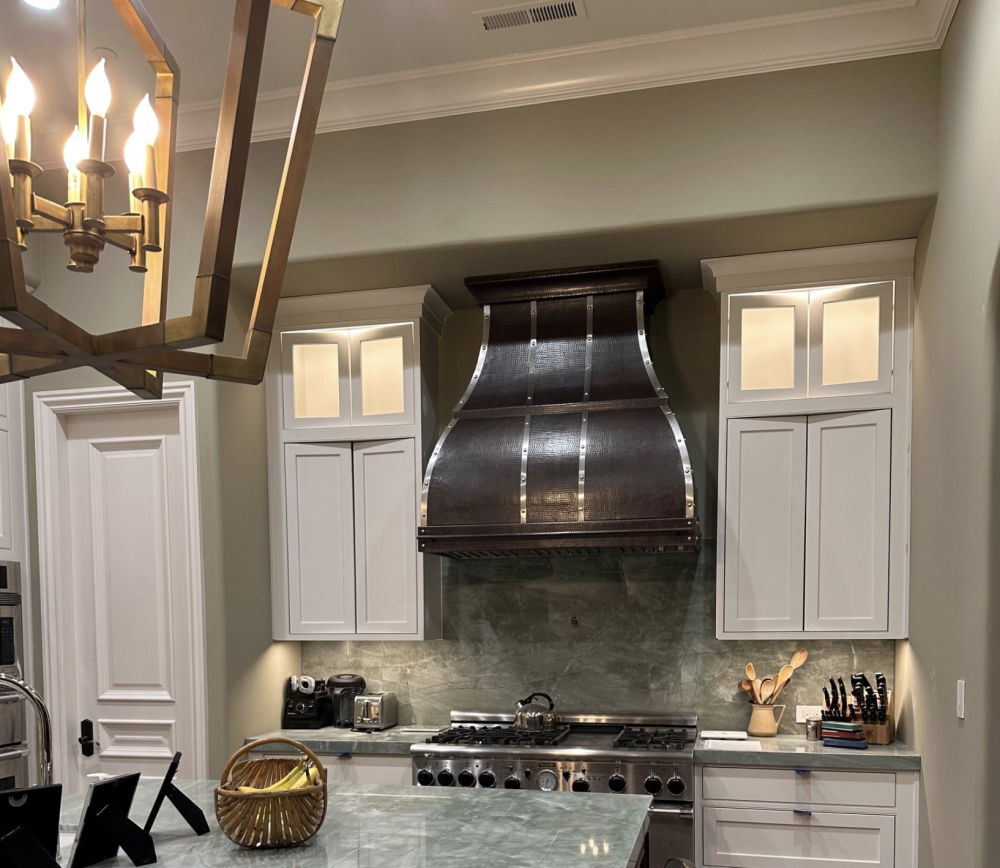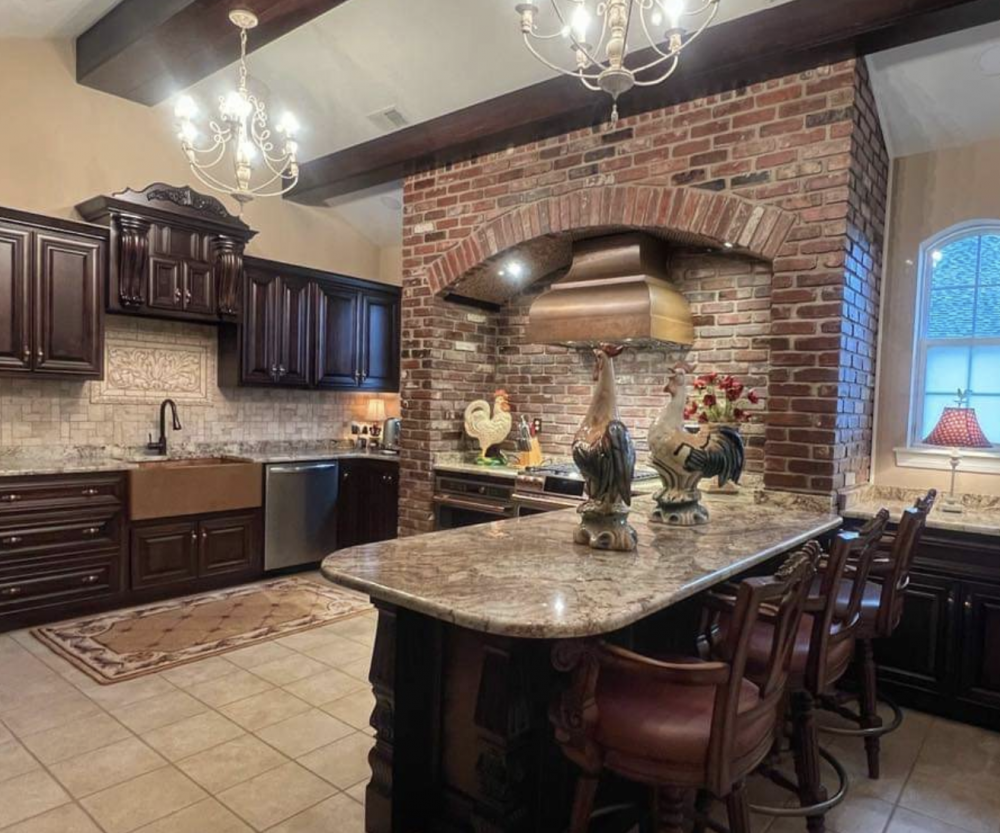Many people think of the kitchen as the heart of their home. It’s where families gather to cook, enjoy meals, entertain, and share experiences. Often, the kitchen is where memories are made. Because the kitchen is such an important part of the home, its design should be both functional and aesthetically pleasing – but this takes careful planning, and many homeowners run into challenges when designing their kitchens. In this article, we discuss eight of the most common kitchen design problems and offer some recommendations for how to avoid them.

Photo Credit: https://www.worldcoppersmith.com/gallery
-
Insufficient Space and Poor Layout
Of all the problems related to kitchen design, insufficient space and a poor layout are among the most common. A cramped kitchen makes it difficult to move around, prepare meals, take care of clean-up chores, and store items properly.
Design recommendations:
- Be sure to allow ample space between countertops, appliances, and storage areas to accommodate ease of movement and accessibility;
- Consider an open floor plan, which will create a sense of spaciousness and improves workflow;
- Maximum the use of space by incorporating smart storage solutions in your design: consider pull-out cabinets, corner drawers, wall-mounted shelves, and other space-saving techniques.
-
Inadequate Lighting
There are numerous reasons why inadequate lighting causes problems in a kitchen, from making tasks like cooking and cleaning more difficult, to a space that feels dark and uninviting – and safety issues.
Lighting recommendations:
- Choose a combination of ambient, task, and accent lighting to create a well-lit and inviting space;
- To illuminate countertops and make tasks like chopping and prepping food easier, install under-cabinet lighting;
- To provide additional lighting and create a focal point, install pendant lights above an island or in the dining area.
-
Insufficient Ventilation
It is crucial to have proper ventilation in the kitchen area; the lack of it can cause problems ranging from lingering odors to excessive humidity. This not only creates an unpleasant atmosphere – it can also cause severe damage to kitchen materials such as cupboards, pantries, and countertops.
Ventilation recommendations:
- Install a high-quality range hood that removes cooking odors, smoke, and moisture from the air;
- Choose a custom range hood with the appropriate cubic feet per minute (CFM) rating based on your cooktop’s size and power;
- Ensure there are enough windows and doors to provide natural ventilation.
-
Inefficient Workflow
An inefficient workflow in the kitchen can make cooking and other tasks more time-consuming and frustrating. Alleviate those issues with a kitchen design that takes efficiency into consideration.
Recommendations for workflow efficiency:
- Follow the “kitchen work triangle” principle, which focuses on the placement of the sink, refrigerator, and stove/cooktop to maximize efficiency and enable you to perform tasks easily and without obstruction;
- Position frequently used appliances and other items within easy reach, and make sure those you use less often can be accessed when you need them;
- Arrange workstations based on specific tasks, such as a prep station, cooking station, and cleanup station.
-
Choosing Inappropriate Materials
When selecting materials for kitchen countertops, cabinetry, and flooring, be sure to
avoid those that can result in premature wear, staining, and a mismatched appearance.
Recommended materials:
- Be sure to research the durability, maintenance requirements, and aesthetics of various materials before making your final choices;
- For countertops, consider options such as granite, quartz, and solid surface materials;
- Choose cabinetry and flooring materials that are resistant to moisture, stains, and scratches, such as engineered wood or high-quality laminate for cabinetry, and porcelain or ceramic tiles for flooring.

-
Insufficient Storage
A lack of storage space in the kitchen can lead to cluttered countertops, problems finding items, and reduced functionality – as well as aggravation. With just a little creativity and planning, you can build storage options into your design.
Storage recommendations:
- Utilize vertical space with wall-mounted cabinets and shelves;
- Install a pantry or tall cabinet to store non-perishable food items and kitchen essentials;
- Use drawer organizers, pull-out shelves, and cabinet dividers to optimize storage space and organization.
-
Mismatched Aesthetics
Although it’s true that looks aren’t everything, an inconsistent or mismatched aesthetic can make a kitchen appear disjointed and less appealing – a place you’d rather avoid than spend time in.
Aesthetic recommendations:
- Decide on a cohesive design theme or color scheme for your kitchen, being sure to consider the overall style of your home;
- Create a harmonious look by coordinating cabinetry, countertops, and flooring materials;
- Choose appliances, lighting fixtures, and hardware that complement the design theme and/or color scheme.
-
Ignoring Ergonomics
The science of ergonomics is typically associated with people’s workplaces, but ergonomic principles apply to the home as well. In kitchen design, for instance, ignoring ergonomics can result in discomfort, strain, and inefficiency when performing tasks.
Ergonomic recommendations:
- Based on the heights and individual needs of primary users, determine the optimal height of countertops, cabinets, and appliances;
- Incorporate features such as adjustable shelves, pull-out drawers, and touchless faucets to increase ease of use and accessibility;
- To avoid collisions and obstructions, be careful to ensure adequate clearance for doors, drawers, and appliances.
Challenging and Rewarding
Designing a kitchen that is both functional and attractive can be challenging – but it’s worth the effort. By avoiding common design problems and following expert recommendations, you can create a space that meets your needs and enhances your home’s value. The most successful kitchen design will result from careful consideration of factors such as layout, lighting, range hoods ventilation, workflow, material choices, storage, aesthetics, and ergonomics.
